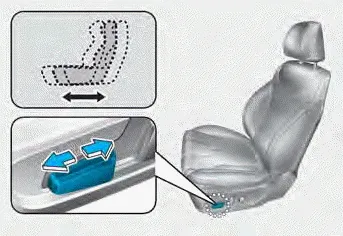Hyundai Santa Fe (TM): Front seats / Power adjustment
The front seat can be adjusted by using the control switches located on the outside of the seat cushion. Before driving, adjust the seat to the proper position so that you can easily control the steering wheel, foot pedals and controls on the instrument panel.
WARNING
NEVER allow children in the vehicle unattended. The power seats are operable when the vehicle is turned off.
NOTICE
To prevent damage to the seats:
- Always stop adjusting the seats when the seat has been adjusted as far forward or rearward as possible.
- Do not adjust the seats longer than necessary when the vehicle is turned off. This may result in unnecessary battery drain.
- Do not operate two or more seats at the same time. This may result in an electrical malfunction.
Forward and rearward adjustment

To move the seat forward or rearward:
1. Push the control switch forward or rearward.
2. Release the switch once the seat reaches the desired position.
Seatback angle

To recline the seatback:
1. Push the control switch forward or rearward.
2. Release the switch once the seatback reaches the desired position.
Reclining seatback
Sitting in a reclined position when the vehicle is in motion can be dangerous. Even when buckled up, the protections of your restraint system (seat belts and air bags) is greatly reduced by reclining your seatback.
WARNING
NEVER ride with a reclined seatback when the vehicle is moving. Riding with a reclined seatback increases your chance of serious or fatal injuries in the event of a collision or sudden stop.
Driver and passengers should ALWAYS sit well back in their seats, properly belted, and with the seatbacks upright.
Seat belts must be snug against your hips and chest to work properly. When the seatback is reclined, the shoulder belt cannot do its job because it will not be snug against your chest. Instead, it will be in front of you. During an accident, you could be thrown into the seat belt, causing neck or other injuries.
The more the seatback is reclined, the greater chance the passenger’s hips will slide under the lap belt or the passenger’s neck will strike the shoulder belt.
Seat cushion tilt (1)

To change the angle of the front part of the seat cushion:
Push the front portion of the control switch up to raise or down to lower the front part of the seat cushion.
Release the switch once the seat reaches the desired position.
Seat cushion height (2)
To change the height of the seat cushion:
Push the rear portion of the control switch up to raise or down to lower the height of the seat cushion.
Release the switch once the seat reaches the desired position.
The front seat can be adjusted by using the levers located on the outside of the seat cushion. Before driving, adjust the seat to the proper position so that you can easily control the steering wheel, foot pedals and controls on the instrument panel.
To move the front part of cushion forward: 1. Push the front part of control switch to move the seat cushion to the desired length. 2. Release the switch once the seat cushion reaches the desired length.
Other information:
Hyundai Santa Fe (TM) 2019-2023 Service and Repair Manual: Heater Core. Repair procedures
Replacement 1. Disconnect the negative (-) battery terminal. 2. Remove the heater and blower assembly. (Refer to Heater - "Heater Unit") 3. Loosen the mounting screws and remove the heater core cover (A).
Hyundai Santa Fe (TM) 2019-2023 Service and Repair Manual: PTC Heater (Diesel only). Description and operation
Description The PTC (Positive Temperature Coefficient) heater is installed at the exit or the backside of the heater core. The PTC heater is an electric heater using a PTC element as an auxiliary heating device that supplements deficiency of interior heat source in highly effective diesel engine.
Categories
- Manuals Home
- Hyundai Santa Fe Owners Manual
- Hyundai Santa Fe Service Manual
- Folding the side view mirror
- Electronic Parking Brake (EPB) warning light. AUTO HOLD indicator light
- Heating,Ventilation And Air Conditioning
- New on site
- Most important about car
